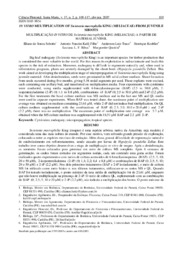In vitro multiplication of Swietenia macrophylla King (Meliaceae) from juvenile shoots.
In vitro multiplication of Swietenia macrophylla King (Meliaceae) from juvenile shoots.
Autoria: SCHOTTZ, E. de S.; KALIL FILHO, A. N.; TRACZ, A. L.; KOEHLER, H.; RIBAS, L. L. F.; QUOIRIN, M.
Resumo: Big-leaf mahogany (Swietenia macrophylla King) is an important species for timber production that is considered the most valuable in the world. For this reason its exploitation is indiscriminate and leads this species to the risk of extinction. Moreover, mahogany is difficult to regenerate naturally and, when used in reforestation programs, plants are severely damaged by the shoot-borer (Hypsipyla grandella Zellar). This work aimed at developing the multiplication stage of micropropagation of Swietenia macrophylla King using juvenile material. After desinfestation, seeds were germinated in MS solid culture medium. Shoot formation from seeds occurred during five months, giving 5.54 nodal segments per seed. These explants were excised, each containing one axillary bud, and transferred on multiplication media. Four experiments with cytokinins were conducted, using media supplemented with 6-benzylaminopurine (BAP) (2.5 to 50.0 ?M), 2- isopentenyladenine (2-iP) (0; 1.1 to 8.8 ?M), combinations of BAP (0; 2.5 to 50.0 ?M) and 2-iP (2.2 ?M). For the first treatments the basal culture medium was MS medium and in the last one MS and QL media were used in separate experiments. When BAP was tested alone, the maximum point of multiplication rate average was obtained on medium containing 23.61 ?M, while 2-iP did not induce bud multiplication. On QL culture medium supplemented with the combinations of BAP (0; 2.5; 5.0; 10.0 e 20.0 ?M ) and 2-iP (2.2 ?M), there was no multiplication. The maximum point of multiplication rate average was 5.7 ?M, obtained when the MS culture medium was supplemented with 18.51 ?M BAP and 2.2 ?M 2-iP.
Ano de publicação: 2007
Tipo de publicação: Artigo de periódico
Unidade: Embrapa Florestas
Palavras-chave: Mahogany, Tropical species
Observações
1 - Por padrão são exibidas publicações dos últimos 20 anos. Para encontrar publicações mais antigas, configure o filtro ano de publicação, colocando o ano a partir do qual você deseja encontrar publicações. O filtro está na coluna da esquerda na busca acima.
2 - Para ler algumas publicações da Embrapa (apenas as que estão em formato ePub), é necessário ter, no celular ou computador, um desses softwares gratuitos. Sistemas Android: Google Play Livros; IOS: iBooks; Windows e Linux: software Calibre.
Acesse outras publicações
Acesse a Base de Dados da Pesquisa Agropecuária (BDPA) para consultar o acervo completo das bibliotecas da Embrapa.

